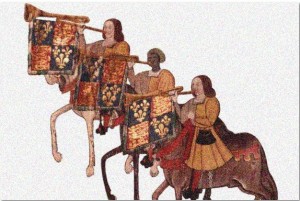“What is the city but its people?
True, the people are the city.”
William Shakespeare, Coriolanus, Act III Scene I.
Many historians regard the Tudor period as pivotal in the shaping of modern England.[1] Despite this, popular interest has concentrated on the more ‘entertaining’ aspects of the period: such as the personal relationships of Tudor Kings and Queens. And not on the diversity present in port towns such as: Bristol, Exeter, London, Plymouth and Southampton during this time.
During the fifteenth and sixteenth centuries Africans were living in the towns mentioned above, and these people were a significant and visible presence in London in the parishes of St Botolph (Aldgate), St Olave and Hart Street; and in Plymouth (St Andrews). This is confirmed by the parish records in these areas where Africans are described as: ‘Blackamoores,’ ‘Ethiopians,’ ‘Moors,’ and ‘Negroes.’ [2] In Tudor England, these terms were interchangeable, and described people who had their origins from Africa — albeit that some came through the Iberian Peninsula.[3] These Africans included ‘Christopher Cappervert a blackemoore,’ ‘28 years’ old,’ buried in St Botolph on 22 October 1586, and described as having ‘dyed in the whitbell of the high street.’ There were also people such as Domingo, described as ‘a negroe,’ ‘Ginnye [meaning from West Africa]’ and a ‘black … servaunt unto Sir William Winter.’ William Winter was an admiral, colleague and rival of the notorious pirate John Hawkins of Plymouth. Domingo was forty years old when he died of consumption on 27 August 1587. In the same parish Cassangoe died of the plague when he was twenty years old. He was buried on 8 October 1593. He was described as ‘a blacke A moore servant to … Mr Thomas Barbor a marchaunt’. [4] And in Plymouth people such as Bastien and Mary lived. Bastien was buried there on 10 December 1583 and was referred to as ‘a Blackmoore of Mr Willm Hawkins;’ and Mary was described as a ‘negro of John Whites.’ She had a daughter called Cristien, ‘the supposed’ child ‘of John Kinge, a Dutchman.’ This illegitimate child was baptised on 17 November 1594 at the local church.[5]
In Southampton, from the fifteenth until the sixteenth centuries, there are numerous records of Africans employed on local ships, and for a range of employers such as Maria Moriana who worked for a Filippo Cini from Genoa (now Italy).[6] And of course English pirates operating from port towns, through an organisation known as the Merchant Adventurers, raided foreign ships. These merchants such as Martin Frobisher, Jon Lok, Sebastian Cabot and Paul Banning, sometimes became slave traders: kidnapping people and selling them abroad to whomever would buy them. But this should be seen in context, as this trade especially in the sixteenth century was ‘troublesome,’ as it was being conducted by Englishmen in opposition to the great powers of Europe, of which England was not. But also because Elizabeth I and Robert Cecil (one of her chief ministers) were not convinced that slavery would produce long-term profits.[7]
So it would be wrong to assume that all the Africans present in Tudor England and those who lived in port towns were slaves. This idea is underlined by the failure of the letters written by the English opportunists Thomas Sherley, Edward Banes and a Dutch slave trader called Casper Van Senden. These letters dated 11 and 18 July 1596, and a Proclamation (1601) failed to grant these men the power to treat Africans in Tudor England as slaves.[8] Most Africans in Tudor England appear to have been integrated members of their parishes, and an integral part of the life of the port towns they lived in.
References
[1] Among these writers’ works include: David Starkey, Crown and Country (London: Harper Press, 2010), introduction; This Land of England (London: Hutchinson, 1985), throughout; Robert Tittler and Norman Jones (eds.), Companion to Tudor Britain (Oxford: Wiley, Blackwell, 2008), et. al.
[2] Imtiaz Habib, Black Lives in the English Archives (London: Ashgate, 2008), introduction; Onyeka, “The Missing Tudors, Black People in Sixteenth-Century England,” BBC History Magazine, 13, no. 7, (July 2012), 32–33.
[3] Please see Onyeka, “What’s in a Name?” History Today, 62, no. 10, (October 2012), 34–39.
[4] These records are to be found at Guildhall Library, Aldermanbury, London, EC2V 7HH, GL Ms 9243–9245, GL Ms 4310, GL Ms 9222.
[5] The Plymouth records can be found at Plymouth and West Devon Record Office, Community Services Department, Unit 3 Clare Place, Plymouth, PL4 0LW, Registers of St Andrews (RSA), MF1–4.
[6] On Maria Moriana see, National Archives, Kew, London, Early Chancery Proceedings (ECP), C1/148/67.
[7]Their views are recorded in: Calendar of the Manuscripts of the Most Honourable the Marquess of Salisbury (London: Historical Manuscripts Commission, 1883–1976), Vol. 10, 399.
[8] These documents can be found at the National Archives, Kew, PC 2/21, p. 304; 11 July 1596; PC 2/21, f. 306, 18 July 1596; Tudor Royal Proclamations, 1601/ 804.5-805; and Calendar of the Manuscripts … Senden, Sherley, “Cecil Papers Petition, Merchant of Lubeck to the Queen,” vol. 14, 143.











Great.